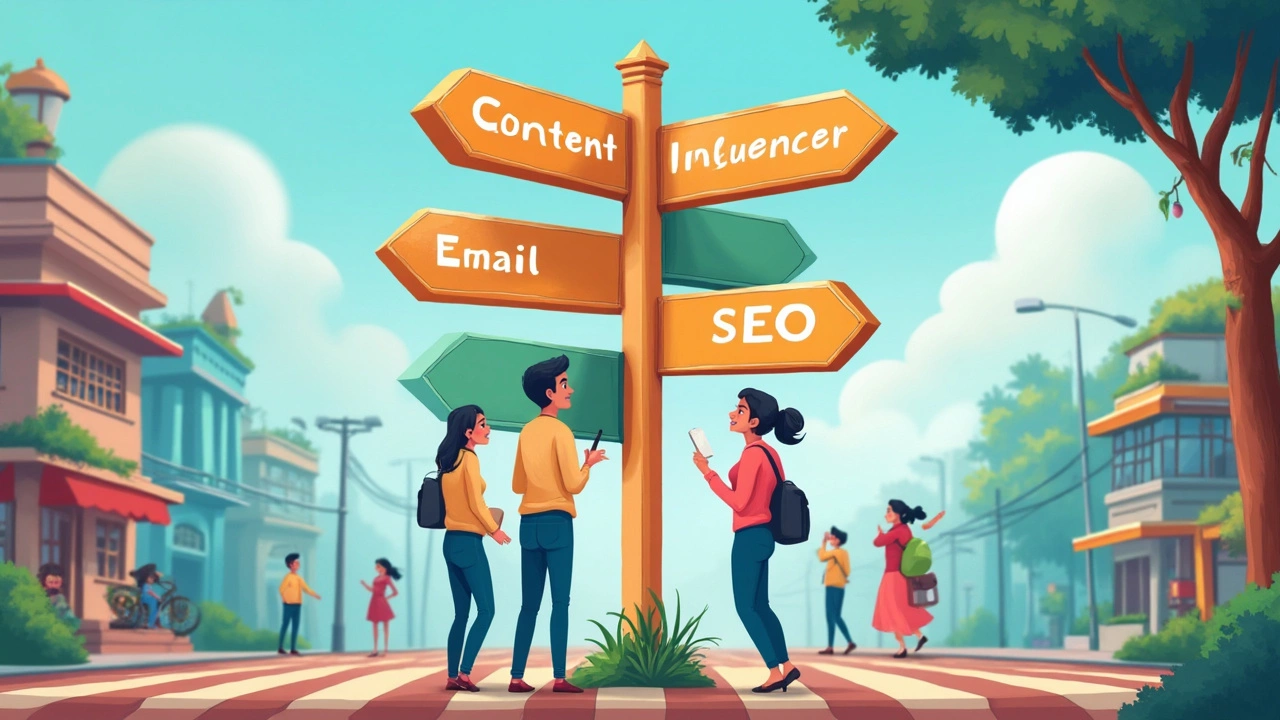Most people scroll through endless lists of digital marketing options and just freeze. Should you start with paid ads? Should you write blogs, post reels, or start shooting emails? You’re not alone if all of this leaves you wondering, “Which type is actually best for someone with zero experience?”
Here’s a fact that surprises a lot of beginners: You don’t need fancy tools or big budgets to get your first results. The trick is to pick a type of digital marketing that matches your skills and keeps you motivated. There’s no one-size-fits-all answer, but some methods are way simpler if you’re just getting your feet wet—and can actually build your confidence fast.
If you can use Instagram, write a simple email, or talk about your favorite topic for a minute, you already have what it takes to start. Let’s jump into the options that make sense for beginners, and see how you can use them to kickstart your skills and maybe even land your first clients.
- Why Beginners Get Overwhelmed
- Social Media Marketing: Easy Entry Point
- Email Marketing: Low Cost, Big Impact
- Content Marketing: Building Trust Step by Step
- Mixing and Matching for Fast Results
Why Beginners Get Overwhelmed
If you’ve ever Googled "how to start in digital marketing," you probably ended up with ten tabs open and a ton of confusion. There are dozens of strategies, platforms, and tools—each claiming to be the secret to getting noticed online. No wonder most beginners bounce between YouTube tutorials, free courses, and Reddit threads, not sure where to even begin.
One big reason for the overwhelm? There’s just too much info out there. In 2024, there were actually more than 8,000 digital marketing tools on the market. And each tool often says you need it to win. Feeling lost is totally normal, especially when you see words like "automation," "conversion optimization," or "user intent" flying at you before you know what they mean.
Here’s a quick breakdown of why beginners hit this wall:
- digital marketing promises fast results, but rarely shows the behind-the-scenes learning curve.
- Most free resources only cover the basics or show advanced hacks, skipping what you actually need in the middle.
- People get told to "do everything": manage social, run ads, send emails, write content, build funnels. That’s not realistic for one person starting out.
- The initial setup for some channels—like paid ads or SEO—calls for terms, budgets, and analysis tools most folks have never touched.
Check this out. Statista reported in April 2025 that newbie marketers spent an average of 15 hours just picking the right platforms before they even created a single post or ad. So, it’s not just you if you feel stuck at the starting line.
| Common First Steps | Time Spent (Avg. by Beginners) |
|---|---|
| Choosing a marketing channel | 7 hours |
| Learning platform basics | 4 hours |
| Setting up first campaign/profile | 4 hours |
Bottom line: The flood of choices and advice makes digital marketing seem harder than it is. The smartest move? Start small, cut out the noise, and pick just one method to focus on first. That’s how you actually make progress when you’re new.
Social Media Marketing: Easy Entry Point
If you're looking for a straightforward way to get into digital marketing, social media is your best friend. Over 5 billion people use social media platforms, according to Datareportal’s Global Overview 2024, so your potential audience is massive. The best part? Setting up an account costs nothing, and you already know how to use apps like Instagram, Facebook, and TikTok.
Social media marketing isn’t about going viral overnight. It’s about picking a platform you like, posting useful and honest content, and interacting with people who care about the same stuff. You don’t need to be a pro at video editing or have a fancy camera. Most successful social media pages started with nothing but a phone and a simple idea.
- Start small: Pick just one platform where your audience hangs out. For most beginners, Instagram or Facebook is familiar and simple enough to manage.
- Optimize your profile: Fill in your bio so people get what you do in seconds. A clear profile picture and a link to your website or page helps build trust.
- Be consistent—not perfect: Posting regularly makes a bigger difference than posting perfectly. Stick to a simple schedule, like 3 posts a week.
- Use built-in tools: Platforms like Instagram offer insights that show which posts work. Check them out once a week and focus on what’s getting likes or comments.
- Engage back: Reply to comments and messages. Algorithms push up posts from people who actually talk to their audience.
Don’t waste money buying followers or using dodgy shortcuts. Real results come from actual people who care. Social media is where most beginners get their first taste of online promotion because the feedback is instant and the learning curve isn’t scary. It’s a solid way to get comfortable with digital marketing before trying more complicated stuff.

Email Marketing: Low Cost, Big Impact
Email marketing is hands-down one of the most budget-friendly ways to get started in digital marketing. You don’t need fancy software or design skills to see results—just a way to collect emails and send messages people actually care about. Here’s something wild: For every $1 spent, marketers usually get back about $36. That’s some serious return on investment.
People check their inboxes all day, so your message doesn’t get buried as easily as a social post. Unlike ads or SEO, you control the list; there’s no random algorithm messing with your reach. And if you mess up an email, no problem. Hit resend, tweak your message, and you’re back in the game.
If you’re thinking “But what would I even send?”, start with basic emails:
- Updates about your business or project.
- Simple how-to tips.
- Short personal stories to build trust.
- Special offers or exclusive deals.
Here’s what makes email marketing practical for beginners:
- It’s cheap—Mailchimp, MailerLite, and ConvertKit have free starter plans.
- No coding required. Drag-and-drop tools make it easy to design.
- You can track who opens, clicks, and unsubscribes. That way, you learn what works—fast.
- Email lists are portable. If you switch tools later, your list goes with you.
Check out these real stats about email marketing success:
| Fact | Detail |
|---|---|
| Average ROI | $36 for every $1 spent |
| Open Rate (Average) | 21%-25% across industries |
| Click Rate | 2%-5% on average |
| Starter Platform Cost | Free up to 500 contacts (Mailchimp) |
A smart move: Build your email list early, even if it starts slow. Friends, family, and early fans count. The sooner you begin, the sooner you see what works—and small lists are easier to manage. Just stay regular and be real; authenticity beats fancy designs every time.
Content Marketing: Building Trust Step by Step
When people talk about content marketing, they usually mean things like blog posts, simple how-to videos, podcasts, or even memes. It sounds fancy, but it just means making stuff that’s helpful, answering real questions, and showing what you know. If you’re just starting out, this is one of the easiest ways to show your value—especially if you’re working with a tiny budget.
Here’s the big deal: digital marketing works best when people actually trust you. That’s exactly what content marketing builds. Let’s be honest—nobody believes a random ad anymore. But if you post a helpful guide or an honest review, people start to listen. More than 70% of buyers say they prefer learning about a business from an article instead of an ad.
If you don’t have a website, start small. Post tips or explainers on LinkedIn, Instagram, or even WhatsApp status. You don’t need to be a pro writer either. Just answer people’s questions and show what you know. The more useful you are, the more you stand out.
Here’s why content marketing is great for beginners:
- No technical skills required to start. Your phone and some ideas are enough.
- You can build a portfolio just by sharing real, useful advice.
- It helps you learn fast by researching and simplifying stuff for other people.
- You’ll start to attract an audience naturally—no need to bug friends or pay for ads.
The type of content you make depends on what you enjoy and where your future customers spend time. If you love explaining stuff, try simple explainers or reviews. If talking is easier, go for short videos or voice notes.
Let’s look at what works:
- How-to guides: These make you look like a problem solver.
- Answering common questions: Just search forums and answer what real people are asking.
- Sharing mistakes and solutions: People love learning from someone who’s honest about their journey.
And here’s some real data that shows why this stuff matters:
| Content Type | Trust Ranking (by users) | Effort to Create |
|---|---|---|
| Blog/articles | 1st | Medium |
| Short videos | 2nd | Low-Medium |
| Infographics | 3rd | Low |
| Podcasts | 4th | Medium-High |
If you want to make life easy, start with what you already know, keep it simple, and publish regularly. Use voice typing, basic editing apps, or even just your phone camera. Over time, your skills will improve—and so will your chances of landing leads or a job in digital marketing.

Mixing and Matching for Fast Results
Want to speed things up? Don’t just stick to one digital marketing tactic and hope for miracles. Combining two or three beginner-friendly methods can actually multiply your impact. This approach, called cross-channel marketing, helps you reach more people and reinforce your message without much extra work.
For example, let’s say you’re learning digital marketing by running a small Instagram page. If you collect emails from your followers and send them a monthly newsletter, you’re suddenly not tied to just one channel. Now, if you publish a blog post and tease it in your newsletter and Insta stories, you’re driving traffic from two places instead of one. This simple loop builds momentum faster—and looks impressive on your digital marketing course portfolio.
Here’s a quick mix that works almost everywhere:
- Post weekly tips or updates on social media (like Facebook, Instagram, or LinkedIn).
- Collect email addresses using a basic form—think Google Forms or Mailchimp’s free plan.
- Send out a short monthly newsletter linking to your top social posts or a blog.
This cycle keeps people in your world, even if they miss one update. It also means you’re never starting every post or email from scratch—reuse your best ideas everywhere.
Curious about the difference this makes? Check out the numbers below. This table is based on a survey from HubSpot’s 2024 State of Marketing Report:
| Strategy | Average Audience Growth in 3 Months | Ownership of Audience |
|---|---|---|
| Social Only | 14% | Low (platform controls audiences) |
| Email Only | 18% | High (you control list) |
| Social + Email | 32% | Very High (best of both worlds) |
Don’t be shy about experimenting. If a certain post does well, turn it into a newsletter topic, or ask your email subscribers to follow you on a new platform. The more you weave things together, the less effort you’ll need to keep your audience growing and engaged.



